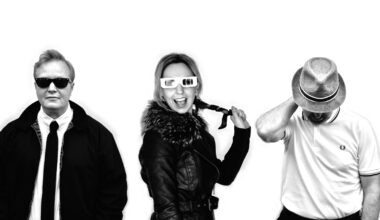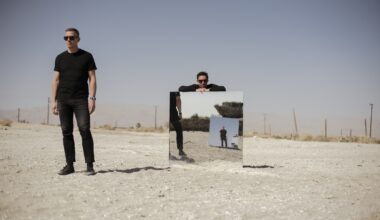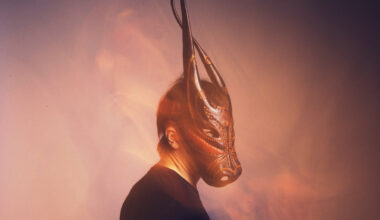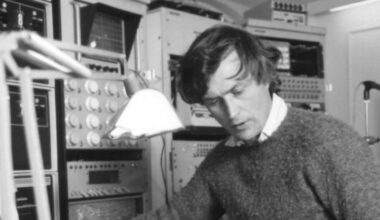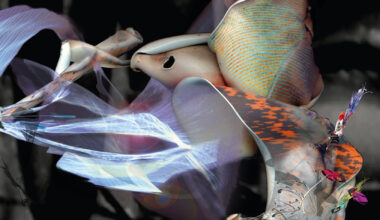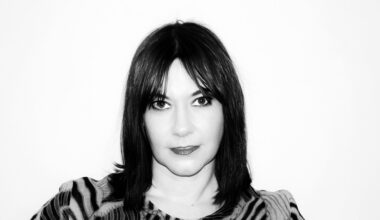From Paris to Vienna to Düsseldorf, our very own man on the train follows the route laid out on ‘Trans-Europe Express’ for a unique Tour De Kraftwerk
I got my first hi-fi for my 15th birthday, in the sweltering summer of 1989. It was Amstrad’s finest, a symphony of clackety plastic and rackety draws, with fetching pink and grey decals. With my hardware patently lacking in sophistication, I compensated with a careful selection of discs to road test it. My relatively late blooming as a record buyer means I can proudly answer the question “What was the first record you bought?” with a resounding “Kraftwerk’s ‘Tour De France’ 12-inch, the Francois Kevorkian remixes, bought from Soho’s Reckless Records, since you’re asking” (worry not, my first cassette albums – Nick Kershaw’s ‘The Riddle’ and a-ha’s ‘Hunting High And Low’ – swiftly deflate any cachet).
That same summer, I tested the jerky action of the CD draw with ‘Trans-Europe Express’. I vividly remember being blown away by the breaking glass effect on ‘Showroom Dummies’. It was the closest I’d got to experiencing 3D sound and felt as though I’d still be picking shards of audial Plexiglas out of my hair for weeks to come. Two years later, my very first bona fide gig was Kraftwerk at the Brixton Academy in London, when they were touring their 1991 greatest hits remix package, ‘The Mix’.
It’s fair to say that Kraftwerk are irrevocably entwined with my personal musical DNA and have had a huge emotional impact on my life in countless ways. As someone who went on to also develop a passion for travelling by train, it’s tempting to muse on how much of that can be attributed to hearing ‘Trans-Europe Express’ in those formative years.
For a teenager living in self-imposed bedroom isolation in suburban Bromley, never having ventured any further towards the glittering shores of continental Europe than Broadstairs, “Parks, hotels and palaces / Europe endless” sure sounded like an impossibly glamorous proposition. I was especially intrigued by Düsseldorf, the mothership and home to the hallowed Kling Klang Studio, my Cavern Club, Brill Building and Salford Lad’s Club all rolled into one.
A few weeks ago, I decided it was high time I made the ultimate music pilgrimage and walked the very allees and strasses where my personal Fab Four strutted their synthesised stuff. Following the route of the old Trans-Europe Express, a rather niche Destination Düsseldorf InterRail adventure is about to begin.
STATION TO STATION
Forgive the brief trainspotter interlude here, but it may interest you to know that the Trans Europe Express was not a single train journey. It was actually an entire European rail network, stretching from Copenhagen to Italy’s Messina Strait (north to south) and from Barcelona to Vienna (west to east). At its height, it took in some 130 destinations.
Established in the late 1950s, the TEE service was aimed squarely at well-heeled business travellers, with First Class only cars and schedules making same-day returns entirely feasible. In an era long before budget airlines criss-crossed the map, before Europe’s first high-speed trains were introduced, and when vast swathes of the continent lay shrouded behind the Iron Curtain, the TEE seemed to express a sense of exciting possibilities and hope for the future. Like the Kraftwerk song itself, it managed to be both nostalgic and futuristic all at once.
Although the TEE network was surpassed by the mid-80s, today’s high-speed trains like France’s TGV and Germany’s ICE keep the spirit of the enterprise very much alive. Their spacious, civilised and often surprisingly affordable services are arguably the envy of Europe. These are the trains that I am taking, following the journey documented by Kraftwerk, from Paris to Vienna to Düsseldorf.
LEAVE PARIS IN THE MORNING
Once Kraftwerk had enjoyed a little international success, they gravitated towards Paris, a city where they remodelled their image away from their staunch Teutonic roots towards a decidedly more European aesthetic. It was here that they were styled and photographed for the ‘Trans-Europe Express’ album cover and where they introduced fragments of French to their linguistic armoury. Paris was also where they first met Iggy Pop and David Bowie, who took them to chichi nightclubs to rub shoulders with the rich and famous.
After all, what self-respecting mid-70s European flâneur wouldn’t want a “rendezvous on Champs-Élysées”, a byword for cosmopolitan urbanity? Nowadays, the boulevard’s last vestiges of glamour are overshadowed by the over-familiar Quick Burgers and Gap stores. The over-priced bistros are still there, but the placements of beggars prostrating themselves on all fours along the pavement may make your fillet mignon a little harder to swallow. Ignore the tall box hedges and Tricolores, squint a bit, and you could easily be on London’s Oxford Street.

The definitive Parisian stop on the Kraftwerk map is Le Train Bleu, the opulent restaurant on the upper floor of Gare de Lyon. With its high ceilings, rococo interiors and old school service, it speaks of the elegance and allure of international rail travel in a way that few modern station eateries do. Despite the heady surroundings, you can enjoy a three-course dinner here for 60 euros a head. So I do just that, treating myself to the house specialty rhum baba, which was accompanied by a bottle of Saint James rum, casually left on the table.
From one side, you can look out onto the train platforms ready to whisk you to Nice, Geneva, Milan and beyond. From the other, the open windows give views of the plaza and the neon signs of L’Européen Bistro. This was the spot where, over dinner with their friend Paul Alessandrini, Ralf Hütter and Florian Schneider hit upon the idea for the ‘Trans-Europe Express’ album. You can well imagine how the rarefied environment of Le Train Bleu inspired excitement for the concept, especially at a time when Kraftwerk’s career and international profile was really gathering diesel. They even celebrated the release of the album by commandeering an entire vintage train for a press junket, shuttling critics to Reims and back, the album’s shimmering contours blasting out from the tinny speakers.
Thinking about it, this also marks the point where the band’s obsession with modes of transport took a greener turn, going from cars to trains before eventually getting to bicycles. If Ralf Hütter ever deigns to spend some time in the studio again, perhaps Kraftwerk’s next opus will be a hymn to the joys of speed walking.
IN VIENNA WE DRIP…
Vienna poleaxes me with an insufferable soup of humidity. I take shelter in the shadow of the Riesenrad, the big wheel at the Prater Amusement Park, where Orson Welles gave his famous cuckoo clock speech in ‘The Third Man’.
Like a late summer wasp, I stagger around the wedding cake-like architectural excesses of the Ringstrasse in a daze, searching in vain for the Franz Schubert Memorial. I finally give up the ghost and settle down for an al fresco pizza in the Stadtpark, a handsome sprawl of greenery with a deep river basin, dotted with crumbling white remnants of almost Romanesque statuary.
Late night cafés are one Viennese institution that’s very much alive and kicking, ranging from lavish hotel drawing rooms serving tea and Sachertorte (a type of chocolate tart) to humbler, more bohemian places where the intelligentsia browse newspapers in cosy booths over steaming bowls of goulash. Sadly, I fail to find one, having banked on discovering a gem by Vienna Meidling station, where the night train to Munich awaits. The area is a virtual wasteland and the closest I get to recreating this key part of my journey is the McCafe by some roadworks next door to the station.
Such are the realities of whistle-stop InterRail trips. The best laid plans of mice and mensch are often taken hostage by mundane practicalities, personal energy levels and basic map reading competency. If only Europe really was endless and life was timeless…
ABZUG MUNICH
Munich doesn’t actually feature in ‘Trans-Europe Express’, but it makes a sensible journey marker none the less, breaking up a 12-hour trip with a utilitarian, but entirely comfy, Hungarian-run night train.
The city does not reveal many obvious Kraftwerk landmarks, but the funny thing about embarking on a laser-focused odyssey like this is that, after a while, everything seems to glimmer with a certain Kraftwerk sheen anyway. One of Munich’s prime tourist attractions, for instance, is the resolutely corporate and palatial BMW Welt. And among all the gauche supercars and F1 testosterone engines sits a humble vintage VW Beetle, as seen through the car windscreen on the original German artwork of ‘Autobahn’.
In the city’s excellent contemporary art gallery, the Lenbachhaus, which houses surrealist paintings of men hunched over transistor radios and surgeons examining their own freshly dissected eyeballs, there’s a room showcasing the disturbing work of Joseph Beuys, one of Düsseldorf’s most influential artists. Meanwhile, on the platform of one of the brightly lit U-Bahn stations, my attention is immediately arrested by what is clearly a poster for Kraftwerk… which turns out to be a furniture showroom.
DESTINATION DÜSSELDORF
A pair of ICE trains finally deliver me to Düsseldorf in eight hours, via a stop-off at Frankfurt Flughafen, another deep warren of corporate chrome and steel that echoes the BMW Welt. Exiting Düsseldorf Hauptbahnhof under a pregnant sky, I’m greeted by a statue of a suited figure wielding a camera mounted on a poster case, a temporary art project by Christoph Poggeler. First impressions reveal a city that is as strikingly modern (there are precious few pre-war buildings) as it is multicultural.

There are rows of 24-hour imbisses (kebab shops, as we know them) and shisha bars flanking the streets around the station and an extensive Japanese district where even the butcher shops serve sashimi steak labelled with kanji. Japanese electronics businesses arrived in the nearby industrial Ruhr Valley in the 1950s, but a sizeable Japanese population chose the more amenable city for their home, which might explain Kraftwerk’s willingness to record Japanese language versions of some of their tracks, such as ‘Pocket Calculator’ (recalibrated as ‘Dentaku’).
DIGITAL DELTA
If Düsseldorf is the “Memphis of electronic music”, then the Rhine is surely the equivalent of the Mississippi. Like the Mississippi, it is broad, powerful and churning. The main Düsseldorf crossing, the Theodor Heuss Bridge, recalls the classic design of San Francisco’s Golden Gate Bridge.
Like every German city worth its sauerkraut, Düsseldorf has a TV tower, the Rheinturm. This one has the world’s largest digital clock, made by Seiko, with an illuminated counter on the exterior giving a precise (if convoluted) read-out, which again seems eminently Kraftwerky. From the bar at the top of the tower, you get a proper sense of the city’s scale and industrial clout. The bar’s neon strip lighting creates laser rays that reach out across the bold Frank Gehry buildings, the construction work bursting from every corner and the freight barges constantly plying the river.
I stop in at Verige, one of the city’s oldest bierhalles, where my request for a coke is gruffly demurred, before ending the night in the boho Bistro Zicke on Berger Allee, the very street where the four robotniks shared a house during their mid-1970s prime. The building at 9 Berger Allee is long demolished, but the bench outside the gastrobar is decorated in homage to Fritz Lang’s ‘Metropolis’. True to form, Kraftwerk have been characteristically elusive on this pilgrimage, but their ghosts are everywhere.
KRAFTWERK IN CONTEXT
Surprisingly, there is no official Kraftwerk guided tour of Düsseldorf, so I take the next best thing – the tourist board’s We Love Music Tour. It was instigated on the back of the city hosting the Eurovision Song Contest in 2011 and it seems that I’m the first person to take the tour in English. Kraftwerk may share the limelight on this tour with other notaries, such as Die Krupps and DAF, but it’s a great way of mapping out the cultural context from whence they came.
The Rhine river walk is one of the city’s main tourist drags, lined with seafood restaurants, bars and cabaret clubs. On the horizon, you can see the skyscraper built by Florian Schneider’s architect father. Across the water, just along from a rickety funfair, is the upmarket district of Oberkassel, where both Hütter and Schneider still live. The tour guide says they do so in virtual anonymity, the city’s youth largely unaware of their existence let alone their influence on the bulk of their listening matter. I ask the guide about the local kids’ jam of choice. “Oh, you know, just the usual R&B shit” comes her off-hand reply.
SHOUTING SCHLAGER SCHLAGER SCHLAGER
In the window of a funeral parlour, there’s an intriguing display in tribute to Udo Jürgens, a much-loved local schlager singer. Schlager was Germany’s contribution to easy listening, a folksy strain of Eurovision-friendly pop. Unapologetically schmaltzy and desperately uncool, it signifies the musical vacuum from which Kraftwerk and their contemporaries emerged.
In an increasingly rare interview, this time with Rolling Stone magazine, Hütter recently proclaimed that “We came from nowhere”. We know this to be true in terms of Kraftwerk’s groundbreaking musical palette, of course, but his Year Zero stance somehow seems all the more valid knowing the state of German post-war pop. That said, and though I’m sure Hütter would be horrified to hear it, there are arguably traces of schlager in some of the band’s charmingly naive English vocals on the likes of ‘Computer Love’ and ‘The Model’.

Aside from schlager, Anglophonic music dominated Düsseldorf’s pre-70s musical landscape, thanks largely to the influence of British Forces Radio. Even Wolfgang Flür started out in cover bands like the Beathovens, bashing out ersatz Mersey beats in the sweaty pubs and clubs of the Aldstadt district. The area is the main entertainment zone of the city and has been described as “the world’s longest bar” on account of the number and density of its watering holes. BEUYS KEEP SWINGING
Düsseldorf’s wider art scene was far more progressive and experimental, providing another crucial piece of the Kraftwerk puzzle. Our old friend Joseph Beuys played a pivotal role by setting up the legendary Cream Cheese club, a venue for underground art happenings where the band staged their first multimedia shows.
What was once one of Europe’s hippest joints is now a fairly anonymous office building, but you can still see Beuys’ controversial stove pipe sculpture sprouting surreally from the exterior wall of the Kunsthalle Museum. I’m no art historian, but to me it seems to say, “This is modern art, growing unlovingly from the concrete and industrial grime that surrounds us and shapes us, whether you like it or not”. It’s an unfussy manifesto that Kraftwerk would surely endorse.
Later on, I pass the Conservatoire, where Hütter and Schneider first met, and the piano-shaped K21 Modern Art Museum, which played host to one of Kraftwerk’s eight-night 3D residencies in 2013. It was the first time the group had played in Düsseldorf since 1991. I also visit Konigsallee, the centre of the city’s fashion district, avoiding the steely glares of the sharp-suited doormen guarding the Hermes and Prada stores on the elegant Parisian-style boulevard. It was here that Claudia Schiffer was discovered. Fashion has long been one of Düsseldorf’s key industries, providing plenty of inspiration for the likes of ‘The Model’ and ‘Showroom Dummies’ no doubt, not to mention the band’s own iconic sartorial style, exemplified on the sleeve of ‘The Man-Machine’.
NO FLIM FLAM, JUST KLING KLANG
Kraftwerk’s original Kling Klang studio is easily found in a drab courtyard down the decidedly unprepossessing Mintropstrasse, a street bordered by a small island of car tyres and given over to grubby-looking betting shops and strip bars. The building, which is apparently now managed by Schneider’s daughter, still houses a variety of music, film and creative studios with evocative names like Staub Audio and Akustik+Tontechnik.
The old Elektro Müller sign is still there, but there is no fanfare, no plaque, no obvious attempt to commemorate the spot where Kraftwerk slaved over a hot mixing desk for some 35 years, siring most of their classic albums. The only visual clue is a single red and white traffic cone resting beside an orange plastic chair by the courtyard entrance. Coincidence or an oblique nod to those in the know? As ever, the Kraftwerk enigma remains deliciously intact. Outside there are bags of junk on the street alongside a discarded video player and a Hoover. Maybe these are part of the impromptu “tribute installation” too?
Turn left out the courtyard and it all makes perfect sense. Within a few steps, you can see the imposing brown brick tower of Düsseldorf Hauptbahnhof, leaving you with no doubt that Kraftwerk’s recording sessions would have been punctuated by a regular backing track of the trains’ grinding brakes, screeches and, well, metallic klings and klangs. The rhythms of the rails must have been etched onto the group’s psyche before the ‘Trans-Europe Express’ album was even a glint in Hütter and Schneider’s ears.
Leaving the Kling Klang building behind me, I start thinking about what a fascinating trip this has been. Kraftwerk themselves remain as remote to me as ever, but I now have my own personal mental route map to accompany a record that still sounds wonderfully fresh yet intractably alien more than 25 years after I first alighted on it.

